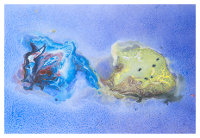Speaker
Semyon Pozdnyakov
(Saint Petersburg State University)
Description
![$A_{+}^{B_{1}} A_{+}^{B_{1}}A_{-}^{b_{1}}A_{-}^{b_{2}}V_{\nu}^{d}$ effective vertex (left); process of interaction of two quark pairs (right)][1]
We study the processes of nucleus-nucleus interaction. The bulk of the amplitude can be represented in terms of pomerons propagating from the multi-nucleon projectile to the multi-nucleon target. The pomeron couples to the separate valence quarks in a hadron, rather than to the hadron as a whole. This particular assumption forms the basis of an internally consistent and extremely successful model. It is consistent with experiment. Phenomenological properties of the pomeron are derived from high energy qq and $\bar{q} q $ total and differential cross-section data. Each pomeron can also split into two ones through a certain known triple pomeron vertex (pomeron fan diagrams).
Our aim is to analyse, if apart from the triple-pomeron coupling one has to account couplings of a larger number of pomerons in nucleus-nucleus interactions. Our immediate problem is to take into account the four-pomeron interaction, which appears when two nucleons from the projectile nucleus interact with two nucleons from the target nucleus in a non-trivial way, that is, with a connected diagram. In the lowest order each nucleon can be imitated by a quark-antiquark loop with at least two gluons attached to it. Still more simplifying, we can substitute the loop by a single quark, provided we assume that it interacts with a double gluon exchange in the colourless state.
This is the problem to be solved by calculating effective vertex $A_{+}^{B_{1}} A_{+}^{B_{1}}A_{-}^{b_{1}}A_{-}^{b_{2}}V_{\nu}^{d}$
To study this process we use the Lipatov effective action, which provides a powerful and constructive technique for the calculation of all Feynman diagrams in the Regge kinematics.
The effective Lagrangian is local in rapidity and describes the
self-interaction of gluons at a given rapidity by means of the usual
QCD Lagrangian
${\cal L}_{QCD}$
and their interaction with reggeons.
It has the form:
![][2]
where
![][3]
The shift $V_\mu\to V_\mu+A_\mu$ with $A_\perp=0$ is done
to exclude direct gluon-reggeon transitions.
The reggeon fields are assumed to be subject to kinematic conditions
$\partial_{-}A_{+}=\partial_{+}A_{-}=0$
In my report I would like to talk about the problem arising in 3 $\to$ 3 reggeons transition, which includes the effective vertex.
The authors (S.P. and M.B.) acknowledge Saint-Petersburg State University for a research grant 11.38.197.2014
[1]: https://dl.dropboxusercontent.com/u/9200230/1.jpg
[2]: https://dl.dropboxusercontent.com/u/9200230/2.png
[3]: https://dl.dropboxusercontent.com/u/9200230/3.png
Author
Semyon Pozdnyakov
(Saint Petersburg State University)
Co-authors
Prof.
Michail Braun
(Saint-Petersburg State University, Russia)
Dr
Michail Salykin
(Saint-Petersburg State University, Russia)
Dr
Michail Vyazovsky
(Saint-Petersburg State University, Russia)
